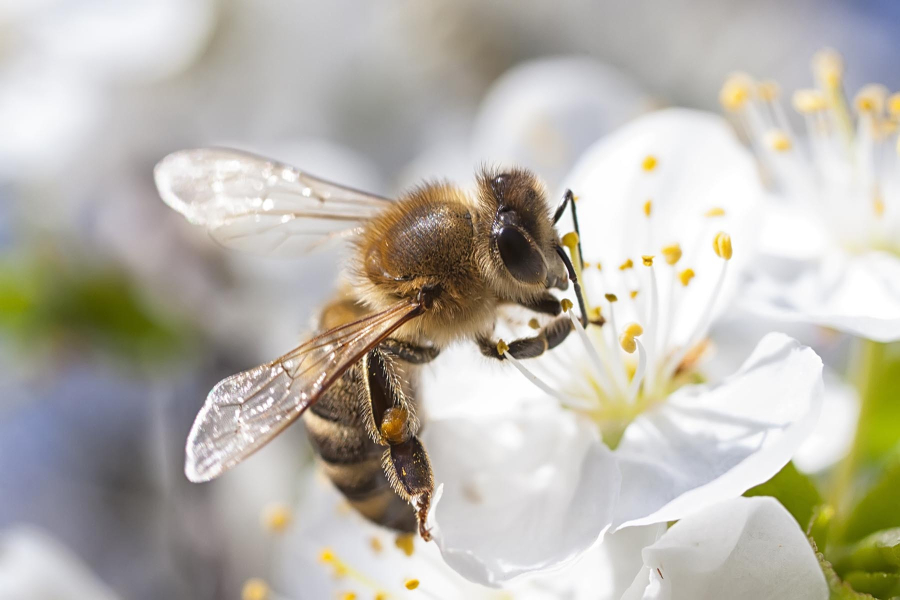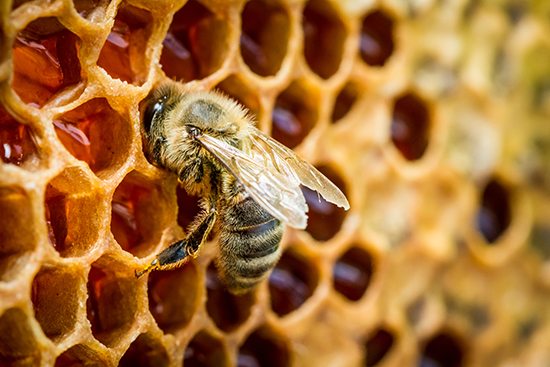Nine buzzworthy facts about the honeybee
Learn some surprising facts about this iconic insect, known for its sweet honey and sharp sting

During the summer months, butterflies, hummingbirds, bats and beetles can be seen darting from flower to flower, collecting nectar and carrying pollen. But no pollinator has quite as close a relationship with humans as the European honeybee. Found on every continent except Antarctica, the honeybee has been facing enormous environmental pressure in recent years, resulting in mysterious mass die-offs. Learn more about this iconic insect—and what you can do to help—with this list of nine honeybee facts.
1. The European honeybee is an introduced species
Honeybees may be one of the most recognized insects in the nation, but they’re actually relative newcomers to North America. Just like sheep, cows and chickens, honeybees were brought from Europe by early settlers, arriving in Virginia around 1622.
2. Those swirling swarms are nothing to worry about
A teeming cluster of honeybees may seem menacing, but a swarm of honeybees is actually when the insects are at their safest. When a colony gets big enough, the queen bee will fly off in search of a new home, taking a portion of the colony with her, while a new queen takes her place in the old colony. Because they’re not defensive of a hive or stores of honey, these swarms pose little threat to humans. They may make brief stopovers on tree branches, walls or road signs, but will most likely take off on their own within a day or two. If a swarm makes you nervous, call a local beekeeper to come safely remove the bees.
3. Honeybees typically only sting when they sense the hive is threatened
When out foraging, bees will rarely sting unless they’re roughly handled. If a bee is buzzing around you, she may smell a flowery perfume or lotion and think the smell is a food source—but if you stand very still, she will realize there is no nectar and fly away.

4. The average American eats one pound of honey each year
To make that pound of honey, a colony of bees would have to fly more than 55,000 miles and visit two million flowers. One bee collects just 1/12 teaspoon of honey in her lifetime.
5. Close to one-third of all the food Americans eat is directly or indirectly benefitted by honeybee pollination.
This amounts to more than $15 billion in crop production each year. Crops like fruits, vegetables, seeds and nuts benefit from honeybee pollination, and some foods—almonds in particular—are completely dependent on honeybees.
6. A syndrome has caused the honeybee population in the U.S. to drop by more than half since the 1940s.
Colonies affected by Colony Collapse Disorder (CCD) appear as a suddenly empty colony—no adult bees or dead bee bodies are near the hive, but the queen and some immature bees may still be present. No causes have been proven, but scientists are researching pesticides, disease, parasites and habitat degradation as possibilities.
7. Honeybees are highly social insects that are able to communicate through complex movements.
Their “round dance” and “waggle dance” allow them to communicate the direction and distance to nectar and pollen. But the use of pesticides—in particular those containing neonicotinoids—may cause disorientation and memory loss, meaning bees have difficulty finding food or returning to their hive.
8. A diverse diet helps bees resist the effects of disease, parasites and even pesticides.
But single-crop fields often lack the variety of plants needed by bees for proper nutrition. By planting wildflowers in marginal land, at the end of fields or along streams, farmers can help provide the variety of pollen and nectar that bees need.
9. To a honeybee or other pollinator, a manicured lawn is more like a desert.
Reducing the size of your lawn and allowing native wildflowers to grow benefits honeybees, native pollinators and other wildlife. You can also plant a pollinator garden, with native plants that flower at different times to provide a consistent source of food.
Looking for ways you can help protect honeybees and other pollinators? Learn what you can do to provide habitat to pollinators and protect them from pesticides.

Comments
One bee collects just 1/12 teaspoon of honey in her lifetime...that's amazing.
Thank you!
Your comment has been received. Before it can be published, the comment will be reviewed by our team to ensure it adheres with our rules of engagement.
Back to recent stories